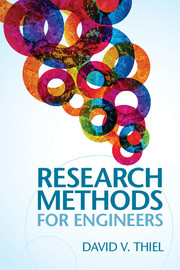Book contents
- Frontmatter
- Contents
- Preface
- An introductory note for instructors
- 1 Introduction to engineering research
- 2 Literature search and review
- 3 Developing a research plan
- 4 Statistical analysis
- 5 Optimization techniques
- 6 Survey research methods
- 7 Research presentation
- 8 The path forward
- Appendix A: Matlab plot functions
- Appendix B: Excel plot functions
- Index
An introductory note for instructors
Published online by Cambridge University Press: 05 September 2014
- Frontmatter
- Contents
- Preface
- An introductory note for instructors
- 1 Introduction to engineering research
- 2 Literature search and review
- 3 Developing a research plan
- 4 Statistical analysis
- 5 Optimization techniques
- 6 Survey research methods
- 7 Research presentation
- 8 The path forward
- Appendix A: Matlab plot functions
- Appendix B: Excel plot functions
- Index
Summary
This course was run at master’s degree level at Griffith University for engineering graduates. For convenience, the book refers to the intended readers of the book as novice researchers, regardless of their status. While the first course was delivered to graduate students, some universities have introduced a research methods course in their engineering undergraduate degree programmes. When teaching the course, we assume the following knowledge gained from undergraduate engineering studies:
A basic understanding of the fundamental concepts and language in a relevant engineering discipline;
Some experience in laboratory experimentation including the application of mathematical laws to plot and understand sets of results;
A basic understanding of measurement theory, errors in measurements and statistics;
The efficient use of a method of analyzing and plotting data (e.g. Matlab or MS Excel).
As a number of the topics in the book are covered in undergraduate engineering degree programmes, the content of this book provides a concise introduction to these concepts. The reader should look to more comprehensive texts for a more careful, detailed analysis or to gain an understanding of the scientific background behind the use of these techniques. Each chapter includes a small list of references. More importantly, readers are given some keywords to conduct searches for further information on any topic.
- Type
- Chapter
- Information
- Research Methods for Engineers , pp. xii - xivPublisher: Cambridge University PressPrint publication year: 2014



